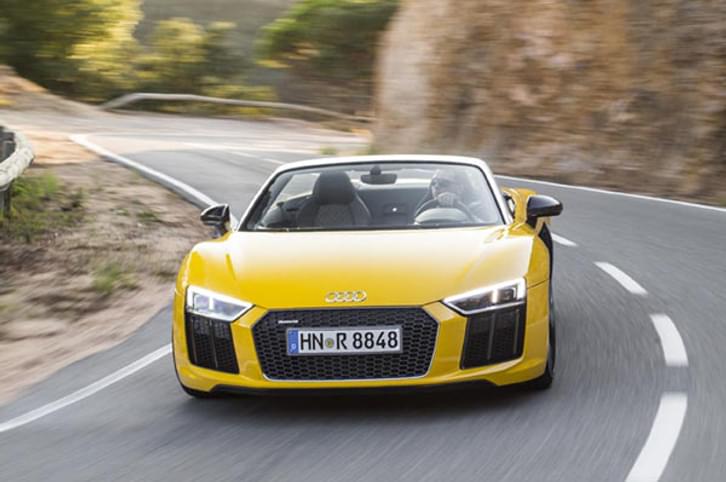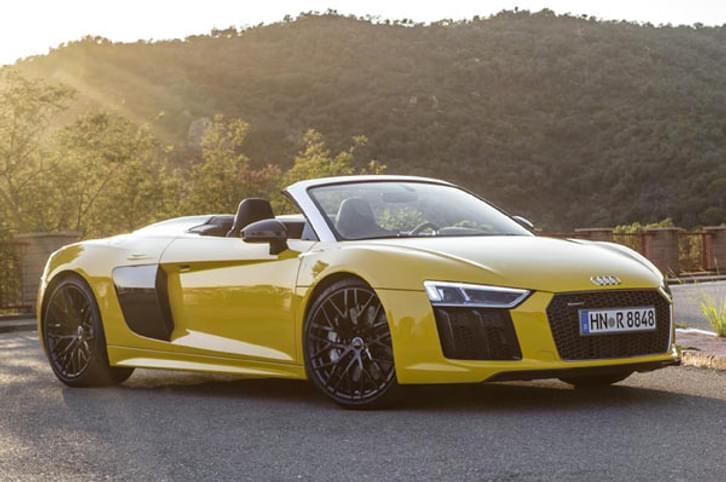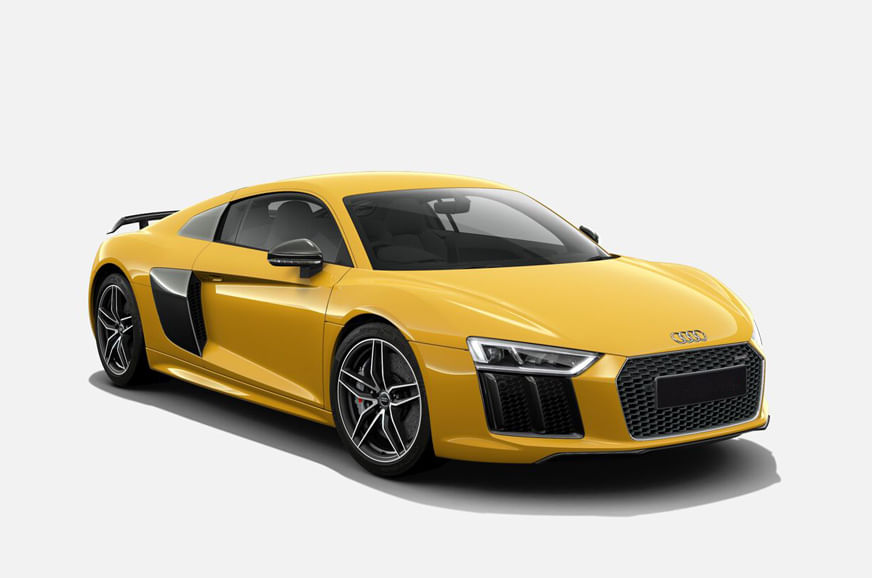2016 Audi R8 V10 Spyder review, test drive
We got a chance to sample the R8 Spyder V10 on the coastal roads in Spain. Here’s what we think of this high-performance convertible.
Updated on Feb 07, 2017 01:49:20 PM
4,961 Views
Follow us on



Audi’s R8 has already been lauded as being the perfect sportscar/supercar – a high performance machine that you can quite easily use every day. What’s more impressive is the fact that this has been applicable through the entire evolution of the car, from its original V8 roots to the second generation of the V10 that came out last year in its 610 horsepower ‘Plus’ specification. This year, this second-generation R8 has gone topless, but just how much difference has peeling off the roof made? Well, quite a bit actually, and with Audi’s mantra for this car being ‘lighter, stiffer, faster’, you’d better believe they mean serious business.
Add lightness (and stiffness)
One massive goal that Audi strived towards while making this new Spyder was to make it lighter and stiffer than the outgoing soft-top. And to achieve this, the entire aluminium-carbonfibre hybrid space has been reworked to give it the strength necessary to deal with the inherent floppiness that goes hand-in-hand with lopping any car’s roof off. Through the use of thicker cross sections of aluminium in certain areas such as the sills, A-pillars and windshield frame, not only is this car lighter and about 50-percent stiffer than the previous generation Spyder, it also has as much torsional rigidity as the last-gen coupé. To put that into perspective, the entire space-frame chassis of this Spyder weighs just 8kg more than the current coupé and the entire car tips the scales at 1,720kg, which is just 80kg over the hard-top.
| Audi R8 Price, Mileage, Specifications, Features and Variants | |
|---|---|
| Brand | Audi |
| Model Name | R8 |
| Audi R8 Price | NA |
| Audi R8 Range/Mileage | NA |
| Audi R8 Specifications | Coupe | 2 doors | 2 seats View All Specs |
| Audi R8 Features | LED headlight | No display | 6 airbags View All Features |
| Audi R8 Variants | V10 Plus View All Variants |
Loaded for performance
The 5.2-litre naturally aspirated V10 motor from the Spyder isn’t available in the ‘Plus’ specification but still makes a fairly ridiculous 540hp of peak power with a more-than-healthy offering of 540Nm of peak torque. With about 15hp more than the previous-generation Spyder, this one is obviously faster when you put your foot down. It can dispense the run to 100kph from a standstill in just 3.6 seconds (two-tenths faster than before) and in a mere 11.8 seconds, it can get to 200kph. On our drive, we certainly got to experience the ferocious way the R8 gets off the line, but there was no way to experience its claimed higher top speed of 318kph.
Speed sensation
While the acceleration certainly is rather impressive, now there’s a whole lot more drama available if you’re so interested as well. When you set the Drive Select mode to Dynamic and floor the throttle, the new sports exhaust roars in an unbelievably loud manner. And as you lift your foot, it sends out loud pops and crackles out the back end. In fact, every time we entered a tunnel during our test drive, we simply couldn’t resist giving the Spyder a boot-full of gas and giggling with juvenile glee as the tunnel walls amplified the sonorous symphony the tail-pipes played. With no roof to separate you from the rock concert coming from the exhaust, that visceral feeling of speed is really turned up to 11. Oh, and we never got tired of all the waves and thumbs-ups we got from onlookers, children and adults alike, as we went past, exhaust screaming for attention.
Of course, when you’re done hooning around, one of the satellite buttons on the steering wheel lets you toggle the flaps in the exhaust to bring the noise to a far more tasteful level, without sacrificing the performance. You can go the other way around as well, by enjoying the ease of Comfort mode and toggling the exhaust button just for some aural drama.
More dynamic than before
Sticking the Spyder in Dynamic mode isn’t purely about the pantomime. In this mode, the electro-mechanical steering weighs up nicely and gets a lot more direct, while the magnetic dampers (optional, but our test cars came equipped) stiffen up the ride, allowing you to feel everything the car is doing through your backside. The seven-speed dual clutch transmission becomes a lot more responsive too, though it’s a lot easier to exploit the motor’s heady 9,000rpm redline using the steering wheel paddles rather than depending on either the automatic D or S modes to do that for you. The quattro all-wheel drive system has been revised as well, and now gets a water-cooled electro-hydraulic clutch for the front axle, as well as a mechanical locking differential at the rear. The amount of grip that the quattro system provides is incredible. Chucking the car through the tight twisty mountain roads around Costa Brava felt extremely easy and even when got overly bold around some of the corners, the car never felt hairy. In fact, that’s one trick that Audi has pulled off quite well with this new generation of R8 (and the Spyder); making it feel a lot smaller than it actually is, and therefore a lot less intimidating to drive.
Apart from the Drive Select modes, the Spyder also comes with optional driving performance programmes, which can be set by pressing the chequered flag button on the steering and then rotating the knurled metal dial around it. These offer three settings – dry, wet and snow, which set the car up even more precisely for those conditions. But since the roads we drove on were exclusively dry, we didn’t really get a chance to explore how the other modes worked.
Lean and green
It’s not just above improved performance with this new Spyder. The boffins at Audi have really worked on the motor to make it more efficient and environmental-friendly than before. While the direct-injection system has been maintained, Audi has also added an indirect-injection system, which squirts fuel into the intake manifold instead of directly in the cylinder. This indirect injection works prominently at lower RPM and provides much better bottom-end response. At the mid-range, while indirect injection is playing a bigger role, the direct injection starts to come into play, and at the top-end, almost 85 percent of the fuelling is done through direct injection. Combined with cylinder deactivation as well as a new coasting feature that will disengage both clutches in the transmission and let the car freewheel if the driver gets off the throttle at speeds above 55kph, making it more efficient than before. Just how efficient? Well, Audi claims a mileage figure of 8.5kpl, which considering that the same engine also makes 540hp, isn’t too bad at all.
Drop that top
The new canvas soft-top is extremely well designed and finished, and weighs in at just 44kg. To operate its mechanism, it features ten small hydraulic pistons driven by an electric motor, which can elegantly open or close the roof in about 20 seconds, at speeds of up to 50kph. However, if you have remotely good weather, the car is a lot more enjoyable with the roof down. Plus, how else will you enjoy the wonderful noise from the exhaust?
Glorious to behold
This second-generation R8 features much sharper lines at the front along with a larger and lower trapezoidal grille, and this carries over on the new Spyder. The engine cover from the coupé of course gets replaced with the cover for the soft-top. And though this part of the design looks quite nice thanks to the two silver stripes with multiple vents running lengthwise, the fact that you can’t quickly pop it open to check out that wonderful V10 motor feels a bit disappointing. The interiors however are definitely up to snuff and the sheer driver focus of the cabin is highly enjoyable. All the controls and knobs are ever so gently tilted the driver side, giving the impression of a purpose-built race car. However, unlike all other Audi sedans and SUVs that you get these days, there’s no central infotainment screen which even the passenger can use. That gets replaced by the 12.3-inch TFT display which replaces the traditional instrument cluster called the Audi Virtual Cockpit. This screen can be used to display the speedometer, tachometer, GPS route navigation and a plethora of other information. This car also gets the new optional laser lights, which really increase the range of the high beams. However, since we didn’t get to drive the car in the dark, there was no way to test how effective they are, and we’ll have to wait for the car to come to India for a thorough test.
India-bound!
The Audi R8 Spyder V10 is an extremely enjoyable car that offers a lot of approachable performance and near everyday practicality. On top of that, it has plenty of performance on reserve which can be thoroughly exploited on a race track. All of that clubbed together with the theatricality of a car offering a million miles of headroom makes it just irresistible. Now, the car is going on sale in Germany next month and will be coming to India by mid-2017. Since it is priced very similar to the R8 V10 Plus coupé in its country of origin, we can estimate that it will be the same story in India and it will be available at about Rs 2.50 crore. While that is plenty of money, that still makes it one of the more affordable supercars in India.
Copyright (c) Autocar India. All rights reserved.




Comments
Member Login
Personal Details
No comments yet. Be the first to comment.